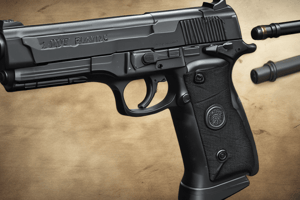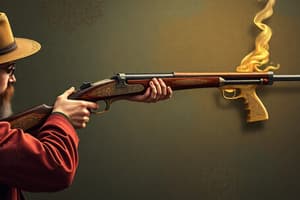Podcast
Questions and Answers
What is the minimum impact rating for safety glasses recommended in the text?
What is the minimum impact rating for safety glasses recommended in the text?
- ANSI Z87.1 (correct)
- ANSI Z87.5
- ANSI Z287.1
- ANSI Z287.5
Why is it important for earmuffs to be snug around the ears?
Why is it important for earmuffs to be snug around the ears?
- To enhance comfort
- To ensure effectiveness (correct)
- To improve hearing
- To reduce noise
What consequences may result from the misuse, loss, or theft of a firearm?
What consequences may result from the misuse, loss, or theft of a firearm?
- Increased firearm accuracy
- Decreased safety concerns
- Reduced firearm maintenance
- Criminal charges and civil liabilities (correct)
When should damaged or dirty hearing or eye protection be used?
When should damaged or dirty hearing or eye protection be used?
What standard does prescription glasses need to carry to be considered sufficient in the text?
What standard does prescription glasses need to carry to be considered sufficient in the text?
What is a major contributing factor in hearing loss as mentioned in the text?
What is a major contributing factor in hearing loss as mentioned in the text?
What is the purpose of personal hearing protection while firing on the range?
What is the purpose of personal hearing protection while firing on the range?
How does long-term exposure to elevated noise levels affect hearing?
How does long-term exposure to elevated noise levels affect hearing?
What is the recommended way to calculate the real-world Noise Reduction Ratings (NRR) according to OSHA guidelines?
What is the recommended way to calculate the real-world Noise Reduction Ratings (NRR) according to OSHA guidelines?
Which type of hearing protection typically provides a lower Noise Reduction Rating (NRR)?
Which type of hearing protection typically provides a lower Noise Reduction Rating (NRR)?
What is the responsibility of the Weapons Training Officer regarding ear protection on the shooting range?
What is the responsibility of the Weapons Training Officer regarding ear protection on the shooting range?
What action should be taken once the command is given to put eye protection in place on the shooting range?
What action should be taken once the command is given to put eye protection in place on the shooting range?
Why must the ball cap be worn by EVERYONE on the shooting range?
Why must the ball cap be worn by EVERYONE on the shooting range?
What is the purpose of wearing ear protection in a manner consistent with its intended use?
What is the purpose of wearing ear protection in a manner consistent with its intended use?
When should individuals be allowed to remove their eye protection on the shooting range?
When should individuals be allowed to remove their eye protection on the shooting range?
What is the recommended procedure to limit lead absorption after handling firearms?
What is the recommended procedure to limit lead absorption after handling firearms?
What should be avoided to prevent lead contamination when handling spent cartridges?
What should be avoided to prevent lead contamination when handling spent cartridges?
What action can increase the rate of lead absorption when handling firearms?
What action can increase the rate of lead absorption when handling firearms?
What is the suggested approach to limit lead injection when handling firearms?
What is the suggested approach to limit lead injection when handling firearms?
What should be done immediately after the discharge of a firearm to prevent skin contact with burning gunpowder?
What should be done immediately after the discharge of a firearm to prevent skin contact with burning gunpowder?
What is a common way lead may enter the human body?
What is a common way lead may enter the human body?
How can shooters help minimize lead exposure?
How can shooters help minimize lead exposure?
Which form of lead exposure is most common with revolvers?
Which form of lead exposure is most common with revolvers?
To limit lead inhalation, one should:
To limit lead inhalation, one should:
What is the recommended action before leaving the shooting range?
What is the recommended action before leaving the shooting range?
What is one potential health hazard that corrections personnel may face on the range?
What is one potential health hazard that corrections personnel may face on the range?
How should firearms always be treated according to the text?
How should firearms always be treated according to the text?
What will happen if you are deemed unsafe by the Weapons Training Officer (WTO) according to the text?
What will happen if you are deemed unsafe by the Weapons Training Officer (WTO) according to the text?
To minimize the risks of health hazards on the range, what precautions should be taken according to the text?
To minimize the risks of health hazards on the range, what precautions should be taken according to the text?
What should corrections personnel understand and abide by on the range regardless of rank or experience?
What should corrections personnel understand and abide by on the range regardless of rank or experience?
What is the protocol for handling dropped firearms on the range?
What is the protocol for handling dropped firearms on the range?
What should be done if someone arrives during actual firing?
What should be done if someone arrives during actual firing?
What should be done in response to a 'Cease-Fire' command?
What should be done in response to a 'Cease-Fire' command?
What is the guideline for nervous habits when handling firearms?
What is the guideline for nervous habits when handling firearms?
How should unnecessary conversation be handled while on or behind the line?
How should unnecessary conversation be handled while on or behind the line?
What is the proper response to dropping equipment like ammo or ear protection while handling a firearm?
What is the proper response to dropping equipment like ammo or ear protection while handling a firearm?
Who should check a dropped firearm before it is fired again?
Who should check a dropped firearm before it is fired again?
What should be avoided when handling firearms?
What should be avoided when handling firearms?
Who should be notified if someone arrives during actual firing?
Who should be notified if someone arrives during actual firing?
What should you do if you drop your ear protection while handling a firearm?
What should you do if you drop your ear protection while handling a firearm?
Flashcards are hidden until you start studying
Study Notes
Home Firearm Safety
- It is your responsibility to safeguard all firearms in your custody.
- The misuse, loss, or theft of a firearm may result in criminal charges, civil liabilities, and/or departmental sanctions.
- Prior to introducing any firearm into the home, a method to safely secure the firearm must first be in place.
Ear Protection
- Ear protection must be worn by everyone on the range while shooting is taking place.
- The use of hearing and eye protection is required on the range whenever firing is taking place.
- Equipment must be clean and in good repair.
- Damaged or dirty hearing or eye protection should not be used until cleaned, repaired, or replaced.
Eye Protection
- Eye protection must be worn by everyone on the range while shooting is taking place.
- Safety glasses with a minimum impact rating of ANSI Z87.1 or higher are required.
- Wrap-around safety glasses are preferred.
- Prescription glasses should be sufficient as long as they carry the ANSI Z287.1 rating.
Hearing Conservation
- Noise exposure is a major contributing factor in hearing loss.
- Continued long-term exposure to elevated noise levels can cause hearing loss.
- One-time exposure to extremely loud noise levels can result in a hearing loss.
- Hearing protectors limit the amount of noise reaching the inner ear, reducing the chances of hearing loss.
Noise Reduction Ratings (NRR)
- NRR is measured in decibels (dB).
- Derived from laboratory testing done under ideal conditions.
- OSHA guidelines recommend that the real-world calculations of NRR can be done by subtracting 7 from the manufacturer's NRR and dividing the results by 2.
Types of Hearing Protection
- Ear Muffs (NRR varies 16dB – 29dB): Lasts longer and is easier to use.
- Ear Plugs (NRR varies 12dB – 32 dB): Proper insertion takes time and training.
- Semi-Aural Caps (NRR varies 17dB – 25dB): Typically provides lower NRR.
Lead Exposure
- Lead may enter the human body by:
- Inhalation: Lead vapor produced upon firing a round.
- Ingestion: Handling food or smoke after being exposed to lead.
- Absorption: Through the skin when handling cartridges containing exposed lead or firearms.
- Injection: When a portion of a lead projectile is shaved off as it enters the bore of a firearm, causing a small fragment to exit the gap between the chamber and the bore with enough force to penetrate the skin.
Limiting Lead Exposure
- To limit lead inhalation: Use ammunition that has a lead-free primer and a jacketed projectile. Limit firing at indoor ranges. Do not leave the range until you have had an opportunity to wash your hands.
- To limit ingestion: Do not eat/handle food or smoke until you've washed your hands and face with soap and cool water after handling firearms, ammunition, or spent cartridges.
- To limit absorption: Avoid touching the face and genitals. Wash all exposed skin with soap and cool water and change your clothing as soon as possible. Be aware that just handling firearms can result in contamination.
- To limit injection: Notify a WTO immediately of any firearm you suspect of shaving. Always keep your non-controlling hand away from any area of a firearm that may result in escaping lead penetrating your skin.
Studying That Suits You
Use AI to generate personalized quizzes and flashcards to suit your learning preferences.



